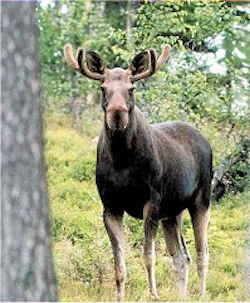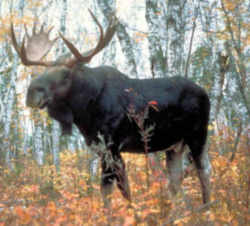Alaska State Land Mammal
Moose

(Alces alces)
Adopted on May 1, 1998.
The moose, (Alces alces,) was made the official Alaska land mammal when Governor Tony Knowles signed SB 265 into law on May 1, 1998 with an effective date of 7/29/98. Moose can be found from the Unuk River in Southeast to the Arctic Slope, but are most abundant in second-growth birch forests, on timberline plateaus and along major rivers of Southcentral and Interior. They are not found on islands in Prince William Sound or the Bering *Sea, on most major islands in Southeast, on Kodiak, or the Aleutians groups.
Alaska State Land Mammal

The Moose is the largest member of the deer family. They are usually dark brown in coloration with long hair. They occasionally have a hairy pendant of skin hanging below their throat. A moose has large ears and a huge, pendulous muzzle. They have long legs and visible humps above the shoulders. The most striking feature of the moose are the antlers (found only in the male moose.) Moose are often easily recognized by their antlers, carried only by the males. Unlike reindeer antlers, the antlers of a moose are very broad and flat. These bony protrusions form within the first year, and are produced every summer after that. The largest recorded antler spread was over 6 feet wide. On average, they are 4.5 feet. The largest sized antlers are usually produced when bulls are 10 - 12 years old, but bulls can reach trophy size as young as 6 years of age. In the wild, moose rarely live more than 16 years. Trophy class bulls are found throughout Alaska, but the largest come from the western portion of the state. Moose are excellent swimmers. They can swim at speed up to 6 miles per hour.
Known as moose across North America, but called elk in Europe, Alces alces is the largest member of the deer family. The Alaska-Yukon race (Alces alces gigas) is the largest of all of these creatures. Adult moose can range in size from 800 pounds (small adult female) to1,600 pounds (large adult male), and they can be up to almost 6 feet tall. Moose can range in color from golden brown to almost black, depending on the season and the age of the animal. Newborn calves have a red-brown coat that fades to a light rust color within a few weeks. By late summer, the calves have shed this coat and grown one that is similar in texture and color to that of adults.
Life History of the Alaska Moose
Growth and Reproduction
Growth patterns, age at sexual maturity, and production of offspring are closely tied to range conditions. A female moose, or "cow,"typically breeds at about 28 months, although breeding has been known to occur as early as 16 months. After a gestation period of about 230 days, cows give birth to calves in the spring. At the time of birth, these babies can weigh in at a mere 28 pounds, but within the first 5 months, calves grow to about 10 times that size. Calves are generally weaned in the fall at the time the mother is breeding again, and they are chased off just before she gives birth in the spring.
An adult male moose engage in the "rut"in late September and early October. During the rut, the males joust by bringing their antlers together and pushing. Serious battles are rare, with most injuries being minor. Occasionally, however, some individuals die from their wounds. The winner typically mates with several females.
Food Ecology
During the fall and winter, moose consume large quantities of willow, birch, and aspen twigs. In some areas, moose actually establish a "hedge"or browse line 6-8 feet above the ground. In the spring, moose also graze, in addition to browsing. During the summer, moose feed on forbs, vegetation in shallow ponds, and the leaves of birch, willow and aspen
Range and Habitat
Moose can generally be found all across the northern forests of North America, Europe, and Russia. In Alaska, moose live in a large area ranging from the Stikine River in Southeast Alaska all the way to the Colville River on the Arctic Slope. They are especially abundant on timberline plateaus; along the major rivers of South central and Interior Alaska; and in recently burned areas that have generated dense stands of willow, aspen, and birch shrubs.
Most moose make seasonal movements to calving, rutting, and wintering areas. They travel anywhere from only a few miles to as many as 60 miles during these transitions
Fast Facts
- Size
Up to 1,600 pounds - Distribution
Generally associated with northern forests; found in Alaska from the Unuk River in Southeast to the Colville River on the Arctic Slope. - Diet
Herbivorous, eating willow, birch, and aspen leaves and twigs, along with sedges, Equisetum, pond weeds, and grasses. - Predators
Wolves, black bears, and brown bears - Reproduction
Usually one calf is born, but twins can occur if food has been plentiful
Alaska Statute
The law designating the moose as the official Alaska state land mammal is found in the 2004 Alaska Statutes, specifically Title 44 (State Government), Chapter 09 (State Seal, Flag, and Emblems), Section 078 (State Land Mammal).
Alaska Statutes.
Title 44. State Government
Chapter 9. State Seal, Flag, and Emblems
Section 78. State Land Mammal.
AS 44.09.078. State Land Mammal.
The moose (Alces alces) is the state land mammal.
Taxonomic Hierarchy: Moose
Kingdom: Animalia
Phylum: Chordata
Class: Mammalia
Order: Artiodactyla
Family: Cervidae
Subfamily: Capreolinae
Genus: Alces - Gray, 1821
Species: A. alces








